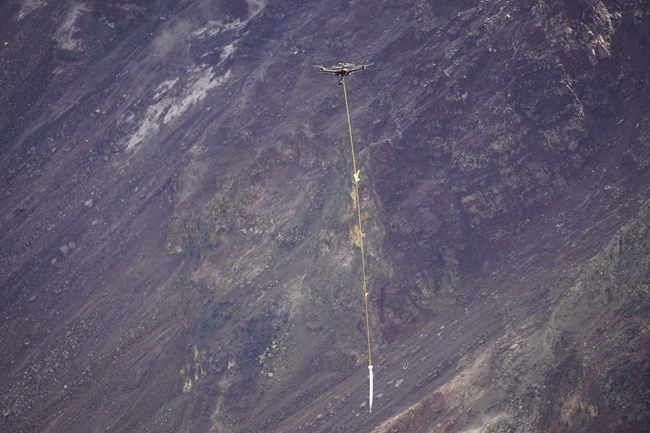|
On August 1, 2019, USGS Hawaiian Volcano Observatory (HVO) scientists confirmed a growing pond of water inside Halemʻumaʻu crater during a helicopter overflight. Similar to the monitoring of the lava lake currently located in Halema‘uma‘u, HVO scientists now relied on both direct observations and modern tools to monitor and document any changes to the water. Due to the summit eruption that began on the night of December 20, 2020, the water lake that was previously forming in Halemaʻumaʻu has now disappeared. How Big Was It?Within the massive Halemaʻumaʻu crater, it can be hard to get a sense of scale. Though it may have looked small, in November 2020 the lake was an astounding 160 feet (49 m) deep, nearly the height of a ten story building. It was approximately 430 feet (131 m) wide by 885 feet (270 m) long, with a volume of nearly 125 million gallons. Where Did The Water Come From? Why Then?Water level rose gradually, suggesting groundwater seepage, not surface runoff. However, testing indicated that the lake water was originally rain that percolated into the subsurface where it became groundwater and the chemistry changed.The lake appeared when it did due to the massive summit collapse that occured in the summer of 2018. When magma drained from the summit of Kīlauea, Halemaʻumaʻu crater collapsed nearly 1,600 feet (500 m), with the bottom of the crater falling below the water table. The water table slowly "bounced back", filling the crater floor. Watch a video from the USGS Hawaiian Volcano Observatory that discusses the appearance of the lake. ColorEarly photographs of the lake in August 2019 showed water that was a bright blue color. Over time, it transitioned to turquoise, yellow, and brown, likely due to the precipitation of iron-sulfate minerals and SO2 being dissolved into the water. The appearance of the water even shifted during the course of a single day.Photographs showed areas of swirling, blue-green color in parts of the lake, likely indicating an influx of new water. 
TemperatureHigh-resolution thermal images indicated that the lake had maximum water temperatures of around 80–85 degrees Celsius (176–185 degrees Fahrenheit). AcidityWater samples taken in October 2019 indicated that the lake had a pH of 4.2, similar to most fruit juices. This put the lake in a unique position in relation to other volcanic lakes around the world. Volcanic lakes elsewhere on Earth tend to be bimodal on the pH scale, either very acidic or alkaline, with very few lakes in the mid-range. A pH of 4.2, however, places this lake in the lonely middle of this distribution. Read a USGS "Volcano Watch" article on the chemistry of the water.
Water SamplingIn October 2019, the USGS Hawaiian Volcano Observatory took the next step in unlocking the secrets of this body of water. They launched a specialized unmanned aircraft system, UAS, that gathered photographs, gas measurements and a water sample from its scalding hot surface. Had This Happened Before?This was the first time in modern history, at least 200 years, that water was visible in the Kīlauea caldera in the form of a lake. In that time period there have been small, ephemeral water features, but nothing on this scale.Over the long geological history of Kīlauea, it is possible there were water lakes in previous eras. Native Hawaiians have told several stories over the centuries in which the volcanic deity Pelehonuamea faced the threat of water drowning her volcanic fires at Kīlauea. Growth of the Water Lake in Halemaʻumaʻu 

Left image
Right image
|
Last updated: December 27, 2022
